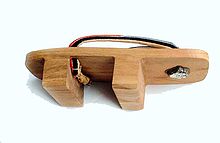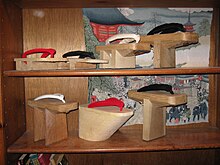Geta (shoes)
The word Geta ( Japanese 下 駄 ) describes Japanese wooden sandals that are worn with traditional clothing such as the kimono . Typical for Geta are the high soles, which in earlier times served to keep the foot at a distance from the rubbish on the street.
Appearance and structure
A strap is attached to the wooden footbed ( 台 dai , literally: base, plateau ) in such a way that it holds the foot between the first and second toe up and from there to the right and left below. The footbed itself rests on a mostly two-part, also wooden sole (similar to the sole and heel in western footwear), which are referred to in Japanese as ha ( 歯 , teeth ). The high sole is intended to lift the wearer's feet from the ground and thus protect them from the mud and rubbish that used to cover the streets.
In the version with two crossbars as a stand, the shortness of the entire contact area enables a certain rolling movement of the foot including the shoe. The gap between the webs reduces the weight of the shoe, increases the grip against slipping in the direction of walking and enables form-fitting climbing in the longitudinal direction on a spherical stone, a transverse log or the edge of a step.
variants
- Ashida ( 足 駄 ):
A Geta variant according to the scheme described above, in which the webs of the sole are higher than with normal Geta. It was worn from the Heian period to the Edo period and was specially designed for use in rainy weather. In the first half of the 20th century, they were also part of school attire in secondary schools, which means that wearing high Geta in combination with a coat and a worn hat was firmly associated with high school students. - Yama-geta ( 山下 駄 ):
A variant in which both the soles and the footbed are seamlessly made from the same piece of wood. It was made and offered by carpenters in particular during the Edo period . Very often the footbed is rectangular in shape and made from the wood of the bluebell tree . - Yoshiwara-Geta ( 吉 原 下 駄 ):
Largely comparable to the Yama-geta described above, but made of sickle fir wood. The strap is made of bamboo fibers . These geta were given to guests in the first half of the Edo period by the establishments in Yoshiwara , Edo's entertainment district , when it rained. -
Pokkuri-Geta ( ぽ っ く り 下 駄 ):
Geta, especially worn by the courtesans of Yoshiwara and Shimabara. Also teaching geisha ( maiko ) wore these Geta variant during their training. It is still generally worn by young girls today. Pokkuri-Geta are quite high and painted black or white on the underside, sometimes also covered with tatami material. They are also called okobo , Koppori and Kobokobo referred. - Robō ( 露 卯 ):
Geta with differently shaped soles, where the nails with which the soles are attached can be seen on the top of the footbed. They were worn in the early Edo period . - Yanagi-Geta ( 柳 下 駄 ):
Geta, in which the footbed is made of willow wood and the sole of magnolia wood. - Ba-geta ( 馬 下 駄 ):
The immediate ancestor of today's Geta: square footbed with differently shaped soles and made of sickle fir wood. The name ("horse geta") comes from the sound that the sloping soles produce when they touch the ground. - Koma-geta ( 駒 下 駄 ):
A further development of the Ba-geta, which are not only intended for use in rain, but also in dry weather. At the beginning of the 17th century they were worn by both men and women as everyday footwear. Until the beginning of the Meiji period , they were the most common Geta variant. - Kiri-Geta ( 桐 下 駄 ):
An expensive Geta variant made from the wood of the bluebell tree (桐, kiri ), which was created as a luxury item shortly after the introduction of the Koma-geta. At first they were painted black, later mainly offered natural. - Odawara-Geta ( 小田原 下 駄 ):
A variant that originated in Tokyo's fish markets at the beginning of the 18th century , and the archetype of the later dry-weather Geta. Their soles could easily be replaced when they were worn out and the leather strap gave them a captivating elegance. Because of their value as status symbols, they were the preferred choice for fish market traders. - Ipponba-geta ( 一 本 歯 下 駄 , "single-tooth geta"):
While Geta generally have a two-part sole, there is also a variant with only a single cross bar per shoe, as Tengu wear. Originally, these geta were worn by street artists and acrobats to show off their own sense of balance.
Nowadays, this model is enjoying new popularity in the wellness and chiropractic sectors, as this Geta variant is said to be beneficial for the sense of balance, body balance and leg muscles.
Distribution and importance
Nowadays, geta are most commonly worn on traditional occasions along with the yukata and sumo fighters. One of the characteristics of the shoe is that you usually hear it before you see it. The wooden footwear emits a typical clack with every step of the wearer. It is sometimes claimed that this is the sound that older Japanese miss most in modern life. On the other hand, it is the sound that every sumo fighter will miss the least, since wearing a Geta is only compulsory in the two lowest leagues . The geishas also wear these shoes in winter. Future geishas (" maikos ") wear different shoes, so-called okobo .
Geta in usage
A Japanese proverb says: You don't know until you've worn Geta. This phrase is used to mean that you cannot know the outcome of a competition before it is over. Because wearing Geta makes a person appear taller due to the high soles, Geta wearing has a figurative meaning: It is used to express that something appears larger or more extensive than it really is on closer inspection.
Or: A fight is not over until you put on the Geta again . Since it is difficult to walk quickly and safely in Geta, and wood slips on many surfaces, in the feudal period of Japan, the Geta were taken off by two duelists before the fight and you fought in tabi or barefoot. Only when the fight was clearly decided did you have time to get back into the Geta.


